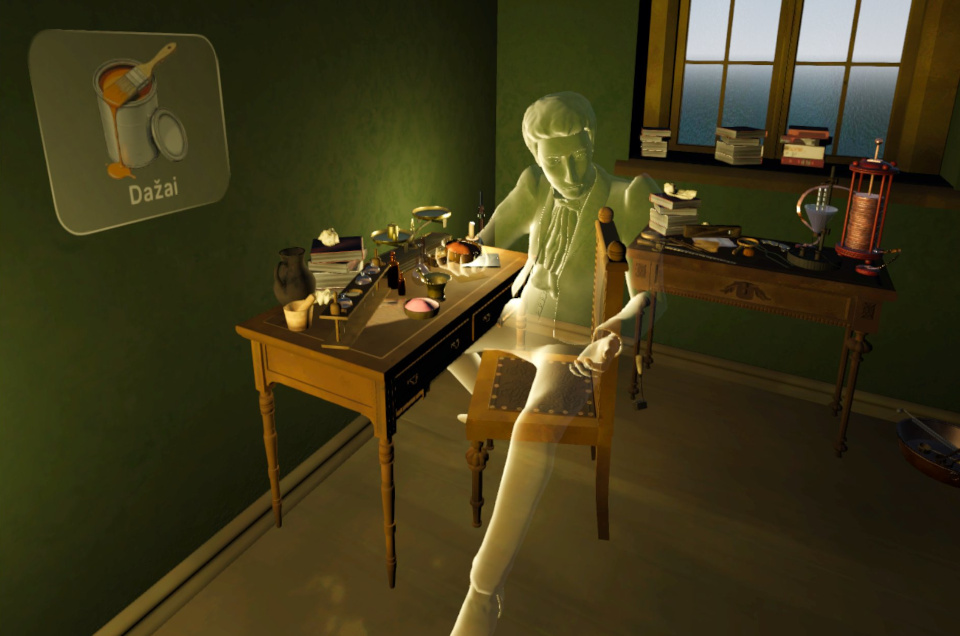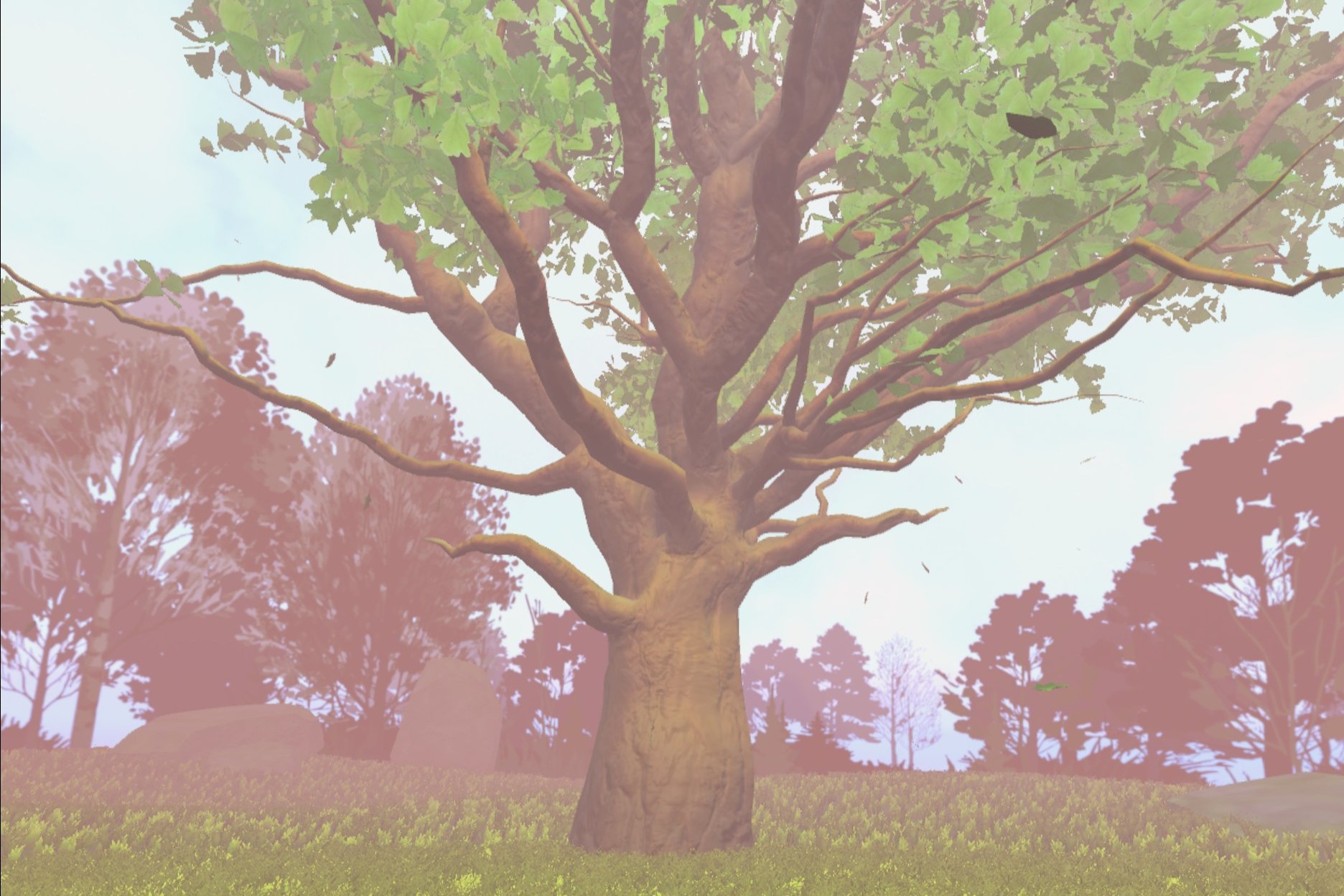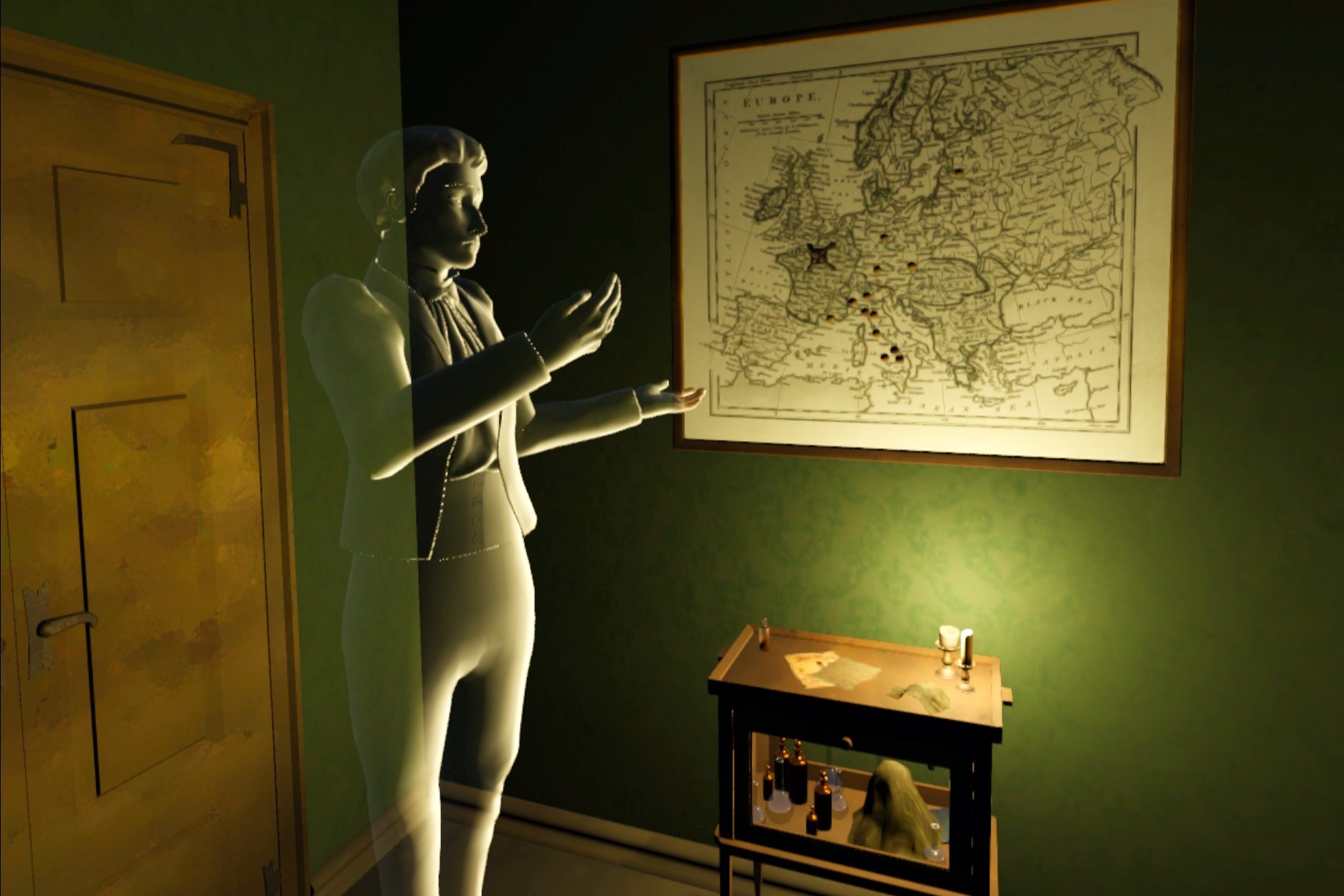Education Reinvented – Interactive VR Experience of Theodor Grotthuss’ Laboratory
An innovative virtual reality (VR) experience at the Žiemgala Museum invites visitors to explore Theodor Grotthuss’ laboratory through a sensory-driven interactive learning journey.

Žeimelis is a town where the name of the 19th-century scientist Theodor Grotthuss has long been known. He was born in the nearby Gedučiai manor, where his path into science began – one that later grew into international recognition. Although his discoveries in photochemistry and electrolysis are globally recognized, to this region, he remains more than a historical figure, he is a living part of its identity.
The Žiemgala Museum aimed to retell Grotthuss’ story in a new and innovative way, allowing visitors to engage deeply with his world and grasp the significance of his scientific breakthroughs. Initiated by the Pakruojis District Municipality and implemented by our interdisciplinary team at Indeform Interactive and Indeform Digital, an interactive exhibition was created, blending authentic objects with cutting-edge technological solutions.
One of the central elements of the exhibition is the virtual reality (VR) experience. It recreates Grotthuss’s research environment, seamlessly integrating it with the physical museum space. This allows us to create a recognizable yet expanded world in which visitors naturally transition into an interactive experience, without distinct boundaries between reality and virtuality.
The VR journey begins at an oak tree – a calm, symbolic space tied to Grotthuss’s life. The oak was chosen deliberately, as local stories suggest he would spend time near this tree studying and developing ideas. It has since been declared a protected natural heritage object and symbolically represents the scientist’s connection with his surroundings. This moment serves as a quiet prelude to the rest of the narrative, bridging the personal bond with nature and the entry into the world of scientific exploration.

The virtual laboratory was designed based on the actual exhibition space in the museum. The interior was modeled according to the aesthetics of the era – the furniture, surfaces, lighting, and materials were all chosen to reflect the period and create a visually authentic, culturally grounded environment. This approach resulted in a familiar yet enriched setting, where the virtual world becomes a natural extension of the physical exhibition.
Within the VR space, the figure of Grotthuss also appears, not as a literal reconstruction, but as a translucent silhouette refracted through light. He stands beside a map, like a memory taking shape, and speaks about his travels and research. The map highlights real locations such as Paris, Italy, and Mount Vesuvius, selected based on historical sources. This scene is directly connected to the physical map in the museum, allowing visitors to continue the narrative they began virtually within the real exhibition environment.

Sound plays an important role in the overall experience. The VR content is narrated in Lithuanian, English, and Latvian to ensure accessibility for international visitors. Attention was given not only to the text itself but also to the rhythm of the narration, including pauses and pacing, to foster focus, reflection, and deeper immersion.
This VR solution is easily adaptable to educational programs, works well for both independent visitors and group experiences, and most importantly, allows the story to be felt on a personal level. It is an interactive space where the visitor becomes an active participant in the process of discovering history. The Grotthuss laboratory experience is one of two VR journeys developed as part of this project. The other focuses on Theodor Grotthuss’s expedition to the volcano Vesuvius – you can read more about it here.
Considering interactive solutions for your museum? We’d be happy to share our experience.
The Client – partnership with the local museum and municipality
The project was initiated by the Pakruojis District Municipality to highlight the significance of this exceptional local figure and offer progressive, community-focused cultural experiences. The Žiemgala Museum, an essential part of Žeimelis' cultural identity, became the home of this interactive Grotthuss exhibit. The museum preserves and presents local history, nature, and community memory. It provided the space and local insights that helped shape the exhibition’s direction and audience expectations. We also collaborated with historians and scientists to ensure historical accuracy.The Problem – need for a modern exhibition format
The project was initiated by the Pakruojis District Municipality to highlight the significance of this exceptional local figure and offer progressive, community-focused cultural experiences. The Žiemgala Museum, an essential part of Žeimelis' cultural identity, became the home of this interactive Grotthuss exhibit. The museum preserves and presents local history, nature, and community memory. It provided the space and local insights that helped shape the exhibition’s direction and audience expectations.The Solution – a VR for the museum
Working with an empty museum space allowed us to design the entire visitor journey from the ground up, from movement flow and stopping points to first impressions. The narrative was developed to be accessible to visitors of all ages, with particular attention to engaging younger audiences. Theodor Grotthuss’s story unfolds progressively through the lens of the person, his surroundings, discoveries, and ideas. You can read more about the creation of the interactive Theodor Grotthuss exhibition by following this link.One of the central elements of the exhibition is the virtual reality (VR) experience. It recreates Grotthuss’s research environment, seamlessly integrating it with the physical museum space. This allows us to create a recognizable yet expanded world in which visitors naturally transition into an interactive experience, without distinct boundaries between reality and virtuality.
The VR journey begins at an oak tree – a calm, symbolic space tied to Grotthuss’s life. The oak was chosen deliberately, as local stories suggest he would spend time near this tree studying and developing ideas. It has since been declared a protected natural heritage object and symbolically represents the scientist’s connection with his surroundings. This moment serves as a quiet prelude to the rest of the narrative, bridging the personal bond with nature and the entry into the world of scientific exploration.

The virtual laboratory was designed based on the actual exhibition space in the museum. The interior was modeled according to the aesthetics of the era – the furniture, surfaces, lighting, and materials were all chosen to reflect the period and create a visually authentic, culturally grounded environment. This approach resulted in a familiar yet enriched setting, where the virtual world becomes a natural extension of the physical exhibition.
Within the VR space, the figure of Grotthuss also appears, not as a literal reconstruction, but as a translucent silhouette refracted through light. He stands beside a map, like a memory taking shape, and speaks about his travels and research. The map highlights real locations such as Paris, Italy, and Mount Vesuvius, selected based on historical sources. This scene is directly connected to the physical map in the museum, allowing visitors to continue the narrative they began virtually within the real exhibition environment.

Sound plays an important role in the overall experience. The VR content is narrated in Lithuanian, English, and Latvian to ensure accessibility for international visitors. Attention was given not only to the text itself but also to the rhythm of the narration, including pauses and pacing, to foster focus, reflection, and deeper immersion.
This VR solution is easily adaptable to educational programs, works well for both independent visitors and group experiences, and most importantly, allows the story to be felt on a personal level. It is an interactive space where the visitor becomes an active participant in the process of discovering history. The Grotthuss laboratory experience is one of two VR journeys developed as part of this project. The other focuses on Theodor Grotthuss’s expedition to the volcano Vesuvius – you can read more about it here.
Value Created – educational, multilingual, immersive VR experience
- Immersive VR experience. A compelling virtual reality experience that immerses visitors in the story and integrates with the museum environment;
- Suitable for all ages. The VR format engages young visitors while offering meaningful content for adults;
- Multilingual narration. Content available in Lithuanian, English, and Latvian, adapted for an international audience.
- Long-term adaptability. The solution is easy to integrate into educational and group programmes, or used for individual visits;
- Sensory-based discovery. Unlike traditional exhibitions, here the visitor doesn't just observe but experiences the content through various sensory inputs. As a result, knowledge becomes more personal, and the experience leaves a lasting impression.
Final Words
Our collaboration with the Pakruojis District Municipality, the museum, and expert partners made it possible to create a distinctive, VR-based interactive experience that immerses visitors in the life of Theodor Grotthuss. Innovative solutions allowed us to merge the physical museum setting with a virtual space, forging a deeper emotional connection to historical content. We believe this project contributes to the strengthening of cultural value.Considering interactive solutions for your museum? We’d be happy to share our experience.
